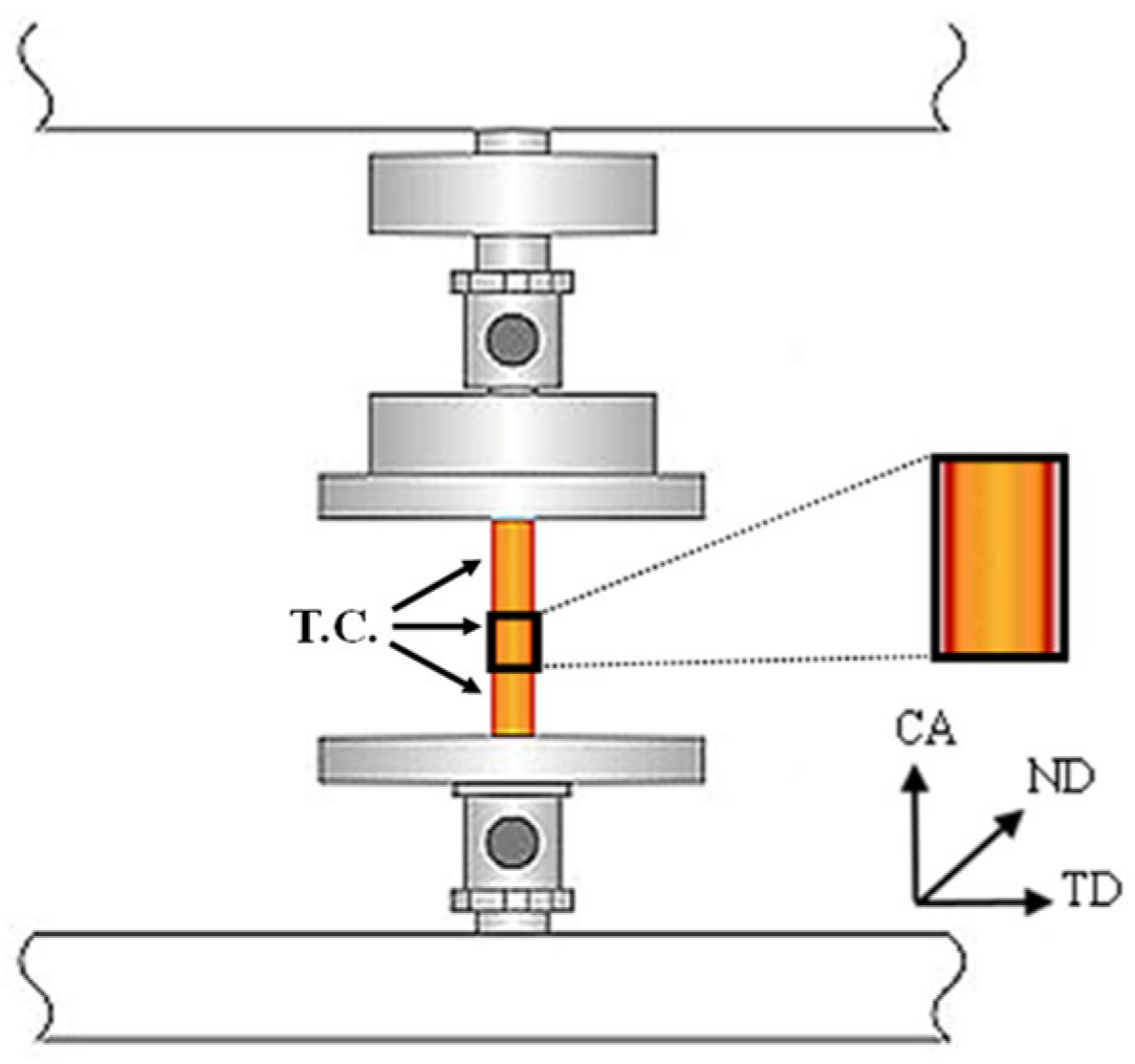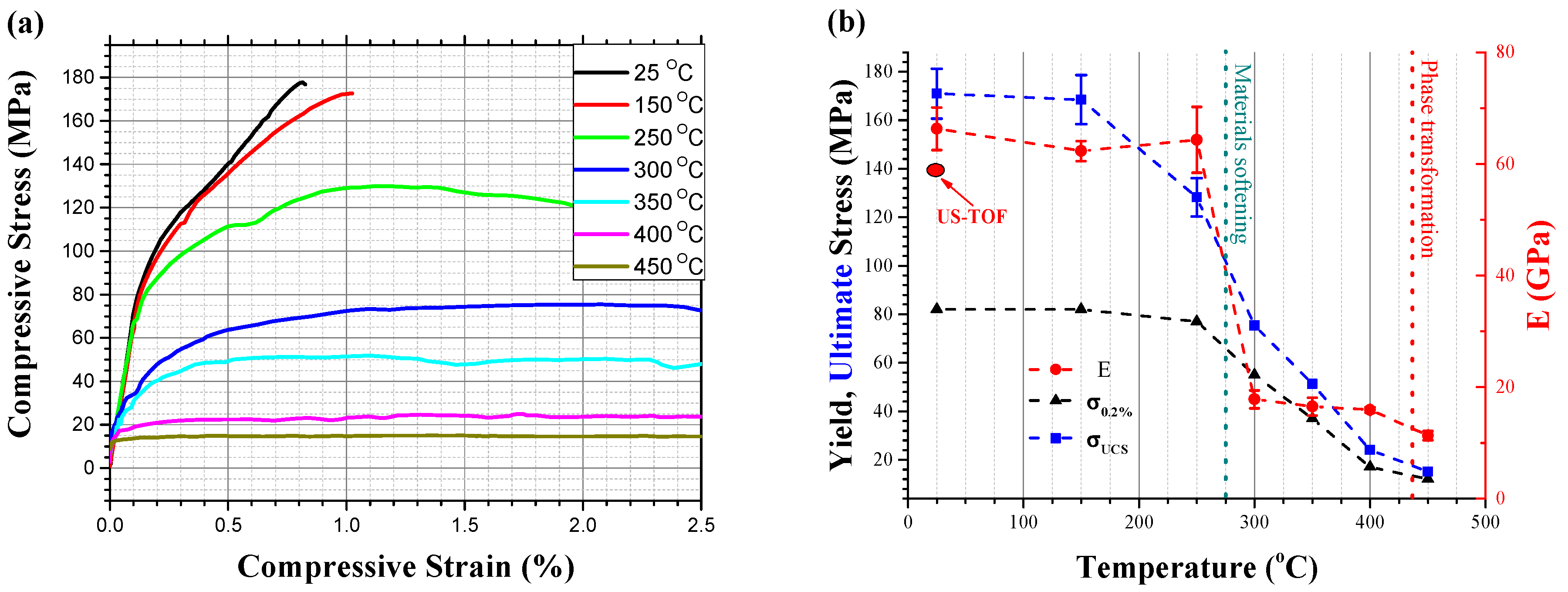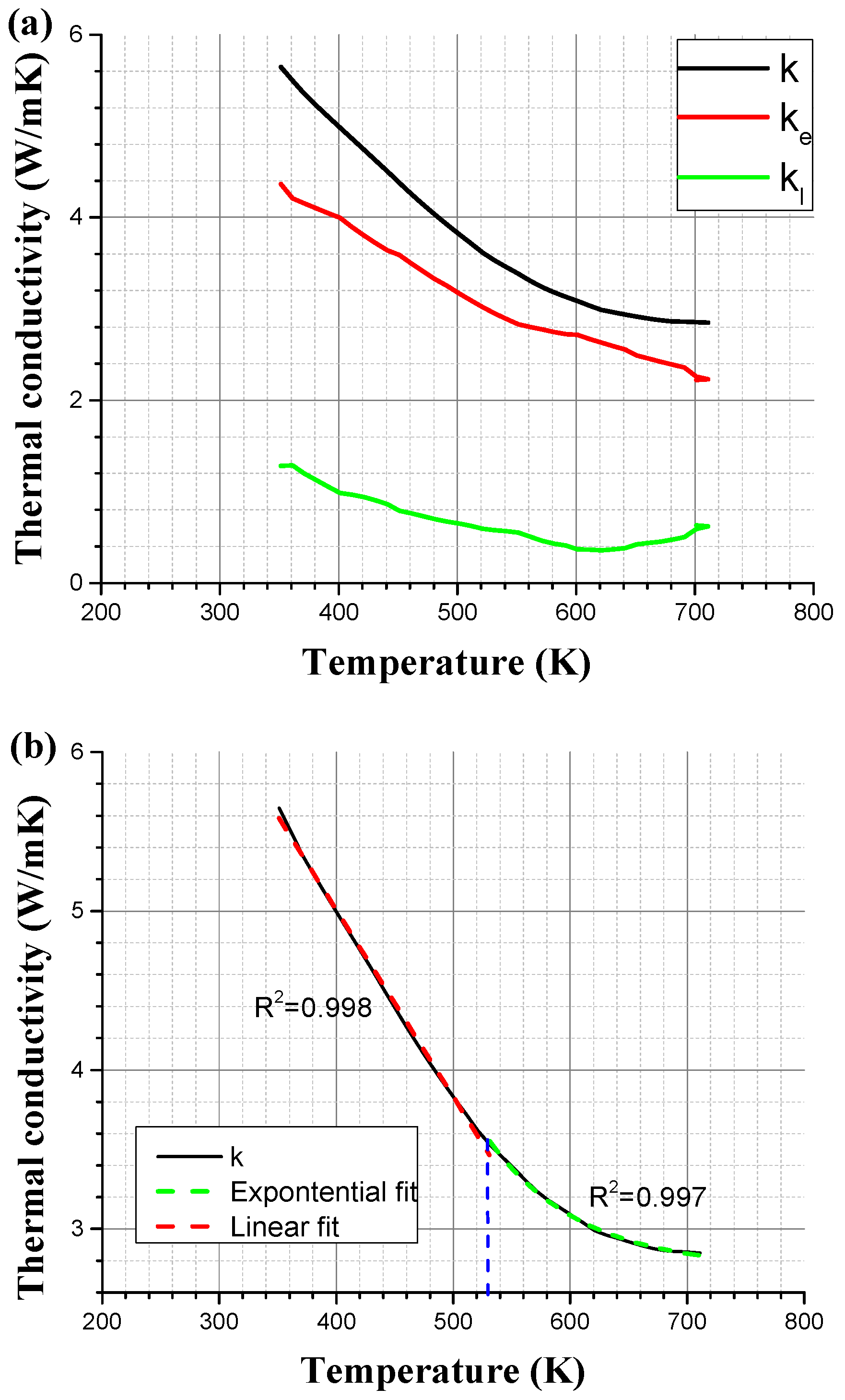The Thermo-Mechanical Response of GeTe under Compression
Abstract
:1. Introduction
2. Experimental Procedure
2.1. Samples Fabrication
2.2. Ultrasonic Time-of-Flight
2.3. Compression Testing
3. Results
3.1. Elastic Constants Determination Using TOF
3.2. Mechanical Testing
3.3. Fracture Surface Characterization
4. Discussion
5. Conclusions
Author Contributions
Funding
Acknowledgments
Conflicts of Interest
References
- Bensaid, S.; Brignone, M.; Ziggiotti, A.; Specchia. High efficiency Thermo-Electric power generator. S. Int. J. Hydrogen Energy 2012, 37, 1385–1398. [Google Scholar] [CrossRef]
- Barako, M.T.; Park, W.; Marconnet, A.M.; Asheghi, M.; Goodson, K.E. Thermal Cycling, Mechanical Degradation, and the Effective Figure of Merit of a Thermoelectric Module. J. Electron. Mater. 2013, 42, 372–381. [Google Scholar] [CrossRef]
- Liao, L.-L.; Dai, M.-J.; Liu, C.-K.; Chiang, K.-N. Thermo-electric finite element analysis and characteristic of thermoelectric generator with intermetallic compound. Microelectron. Eng. 2014, 120, 194–199. [Google Scholar] [CrossRef]
- Guttmann, G.M.; Gelbstein, Y. Mechanical Properties of Thermoelectric Materials for Practical Applications. In Bringing Thermoelectricity into Reality; Aranguren, P., Ed.; InTech: London, UK, 2018. [Google Scholar]
- Guttmann, G.M.; Haroush, S.; Gelbstein, Y. The Mechanical Properties of Inorganic Thermoelectric Materials: A Review on Characterization Methods and Correlations. ChemNanoMat 2022, e202200203. [Google Scholar] [CrossRef]
- Gelbstein, Y.; Tunbridge, J.; Dixon, R.; Reece, M.J.; Ning, H.; Gilchrist, R.; Summers, R.; Agote, I.; Lagos, M.A.; Simpson, K.; et al. Physical, Mechanical, and Structural Properties of Highly Efficient Nanostructured n- and p-Silicides for Practical Thermoelectric Applications. J. Electron. Mater. 2014, 43, 1703–1711. [Google Scholar] [CrossRef]
- Schmidt, R.D.; Case, E.D.; Ni, J.E.; Sakamoto, J.S.; Trejo, R.M.; Lara-Curzio. Temperature-dependent Young’s modulus, shear modulus and Poisson’s ratio of p-type Ce0.9Fe3.5Co0.5Sb12 and n-type Co0.95Pd0.05Te0.05Sb3 skutterudite thermoelectric materials. E. Philos. Mag. 2012, 92, 727–759. [Google Scholar] [CrossRef]
- Schmidt, R.D.; Case, E.D.; Ni, J.E.; Trejo, R.M.; Lara-Curzio, E.; Korkosz, R.J.; Kanatzidis, M.G. High-temperature elastic moduli of thermoelectric SnTe1 ± x − y SiC nanoparticulate composites. J. Mater. Sci. 2013, 48, 8244–8258. [Google Scholar] [CrossRef]
- Zheng, Y.; Xie, H.; Shu, S.; Yan, Y.; Li, H.; Tang, X. High-Temperature Mechanical and Thermoelectric Properties of p-Type Bi0.5Sb1.5Te3 Commercial Zone Melting Ingots. J. Electron. Mater. 2014, 43, 2017–2022. [Google Scholar] [CrossRef]
- Wu, D.; Zhao, L.-D.; Hao, S.; Jiang, Q.; Zheng, F.; Doak, J.W.; Wu, H.; Chi, H.; Gelbstein, Y.; Uher, C.; et al. Origin of the High Performance in GeTe-Based Thermoelectric Materials upon Bi2Te3 Doping. J. Am. Chem. Soc. 2014, 136, 11412–11419. [Google Scholar] [CrossRef]
- Weintraub, L.; Davidow, J.; Tunbridge, J.; Dixon, R.; Reece, M.J.; Ning, H.; Agote, I.; Gelbstein, Y. Investigation of the Microstructural and Thermoelectric Properties of the (GeTe)0.95(Bi2Te3)0.05 Composition for Thermoelectric Power Generation Applications. J. Nanomater. 2014, 2014, 1–7. [Google Scholar] [CrossRef] [Green Version]
- Gelbstein, Y.; Davidow. Highly efficient functional GexPb1−xTe based thermoelectric alloys. J. Phys. Chem. Chem. Phys. 2014, 16, 20120–20126. [Google Scholar] [CrossRef] [PubMed]
- Guttmann, G.M.; Gertner, R.; Samuha, S.; Ben-Ayoun, D.; Haroush, S.; Gelbstein, Y. Thermoelectric and mechanical properties of Ag and Cu doped (GeTe)0.96(Bi2Te3)0.04. MRC 2018, 8, 1292–1299. [Google Scholar] [CrossRef]
- Zhang, X.; Bu, Z.; Lin, S.; Chen, Z.; Li, W.; Pei, Y. GeTe Thermoelectrics. Joule 2020, 4, 986–1003. [Google Scholar] [CrossRef]
- ASTM D2845; Test Method for Laboratory Determination of Pulse Velocities and Ultrasonic Elastic Constants of Rock. ASTM International: West Conshohocken, PA, USA, 2008.
- Davidow, J.; Gelbstein, Y. A Comparison Between the Mechanical and Thermoelectric Properties of Three Highly Efficient p-Type GeTe-Rich Compositions: TAGS-80, TAGS-85, and 3% Bi2Te3-Doped Ge0.87Pb0.13Te. J. Electron. Mater. 2013, 42, 1542–1549. [Google Scholar] [CrossRef]
- Kagdada, H.L.; Jha, P.K.; Śpiewak, P.; Kurzydłowski, K.J. Structural stability, dynamical stability, thermoelectric properties, and elastic properties of GeTe at high pressure. Phys. Rev. B 2018, 97, 134105. [Google Scholar] [CrossRef]
- Goldak, J.; Barrett, C.S.; Innes, D.; Youdelis, W.J. Structure of Alpha GeTe. Chem. Phys. 1966, 44, 3323–3325. [Google Scholar] [CrossRef]
- Guttmann, G.M.; Dadon, D.; Gelbstein, Y.J. Electronic tuning of the transport properties of off-stoichiometric PbxSn1−xTe thermoelectric alloys by Bi2Te3 doping. Appl. Phys. 2015, 118, 065102. [Google Scholar] [CrossRef]
- Schlieper, A.; Feutelais, Y.; Fries, S.G.; Legendre, B.; Blachnik, R. Thermodynamic evaluation of the Germanium–Tellurium system. Calphad 1999, 23, 1–18. [Google Scholar] [CrossRef]
- Perumal, S.; Roychowdhury, S.; Negi, D.S.; Datta, R.; Biswas, K. High Thermoelectric Performance and Enhanced Mechanical Stability of p-type Ge1–xSbxTe. Chem. Mater. 2015, 27, 7171–7178. [Google Scholar] [CrossRef]
- Cook, B.A.; Wei, X.; Harringa, J.L.; Kramer, M.J. In-situ elevated-temperature TEM study of (AgSbTe2)15(GeTe)85. J. Mater. Sci. 2007, 42, 7643–7646. [Google Scholar] [CrossRef]
- Beausir, B.; Fundenberger, J.-J. Analysis Tools for Electron and X-ray Diffraction, ATEX-Software; ATEX-Software; University Lorraine-Metz: Luxembourg, 2017. [Google Scholar]
- Humphreys, F.J. Reconstruction of grains and subgrains from electron backscatter diffraction maps: Reconstruction of Grains and Subgrains from EBSD Maps. J. Microsc. 2004, 213, 247–256. [Google Scholar] [CrossRef] [PubMed]
- Nye, J.F. Some geometrical relations in dislocated crystals. Acta Metall. 1953, 1, 153–162. [Google Scholar] [CrossRef]
- Pantleon, W. Resolving the geometrically necessary dislocation content by conventional electron backscattering diffraction. Scr. Mater. 2008, 58, 994–997. [Google Scholar] [CrossRef]
- Muránsky, O.; Balogh, L.; Tran, M.; Hamelin, C.J.; Park, J.-S.; Daymond, M.R. On the measurement of dislocations and dislocation substructures using EBSD and HRSD techniques. Acta Mater. 2019, 175, 297–313. [Google Scholar] [CrossRef]
- Lavrentev, M.G.; Osvenskii, V.B.; Parkhomenko, Y.N.; Pivovarov, G.I.; Sorokin, A.I.; Bulat, L.P.; Kim, H.-S.; Witting, I.T.; Snyder, G.J.; Bublik, V.T.; et al. Improved mechanical properties of thermoelectric (Bi0.2Sb0.8)2Te3 by nanostructuring. APL Mater. 2016, 4, 104807. [Google Scholar] [CrossRef]
- Snykers, M.; Delavignette, P.; Amelinckx, S. The domain structure of GeTe as observed by electron microscopy. Mater. Res. Bull. 1972, 7, 831–839. [Google Scholar] [CrossRef]
- Zheng, Y.; Tan, X.Y.; Wan, X.; Cheng, X.; Liu, Z.; Yan, Q. Thermal Stability and Mechanical Response of Bi2Te3-Based Materials for Thermoelectric Applications. ACS Appl. Energy Mater. 2020, 3, 2078–2089. [Google Scholar] [CrossRef]
- Gelbstein, Y. Phase morphology effects on the thermoelectric properties of Pb0.25Sn0.25Ge0.5Te. Acta Mater. 2013, 61, 1499–1507. [Google Scholar] [CrossRef]







| References | Young’s Modulus (E) (GPa) | Shear Modulus (G) (GPa) | Bulk Modulus (B) (GPa) | Poisson’s Ratio (ν) | Relative Density (ρrel) (%) |
|---|---|---|---|---|---|
| This work | 59.1 ± 3.6 | 23.4 ± 1.6 | 42.4 ± 0.9 | 0.27 ± 0.01 | 98.5 |
| J. Davidow et al. [16]—TOF | 56.1 ± 0.5 | --- | --- | --- | 98.78 |
| H. L. Kagdada et al. [17] based on first principles calculation | 67.14 | 28.16 | 36.31 | 0.19 | 100 |
| Temp. (°C) | E (GPa) | σ0.2% (MPa) | σuCS (MPa) |
|---|---|---|---|
| 25 | 66 ± 4 | 82 ± 5 | 171 ± 10 |
| 150 | 62 ± 2 | 82 ± 7 | 169 ± 10 |
| 250 | 64 ± 6 | 77 ± 6 | 128 ± 8 |
| 300 | 18 ± 2 | 55 ± 4 | 75 ± 6 |
| 350 | 17 ± 2 | 37 ± 4 | 51 ± 2 |
| 400 | 16 ± 1 | 17 ± 3 | 24 ± 1 |
| 450 | 11 ± 1 | 12 ± 3 | 15 ± 1 |
Publisher’s Note: MDPI stays neutral with regard to jurisdictional claims in published maps and institutional affiliations. |
© 2022 by the authors. Licensee MDPI, Basel, Switzerland. This article is an open access article distributed under the terms and conditions of the Creative Commons Attribution (CC BY) license (https://creativecommons.org/licenses/by/4.0/).
Share and Cite
Guttmann, G.M.; Samuha, S.; Gertner, R.; Ostraich, B.; Haroush, S.; Gelbstein, Y. The Thermo-Mechanical Response of GeTe under Compression. Materials 2022, 15, 5970. https://doi.org/10.3390/ma15175970
Guttmann GM, Samuha S, Gertner R, Ostraich B, Haroush S, Gelbstein Y. The Thermo-Mechanical Response of GeTe under Compression. Materials. 2022; 15(17):5970. https://doi.org/10.3390/ma15175970
Chicago/Turabian StyleGuttmann, Gilad Mordechai, Shmuel Samuha, Reuven Gertner, Barak Ostraich, Shlomo Haroush, and Yaniv Gelbstein. 2022. "The Thermo-Mechanical Response of GeTe under Compression" Materials 15, no. 17: 5970. https://doi.org/10.3390/ma15175970






